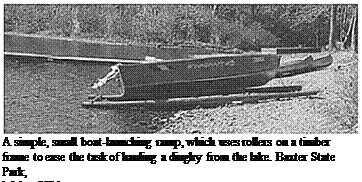If rivers are to be used for bathing, planning must address issues of zoning for different users along different stretches, such as boats fishing and swimming, which may conflict with each other or require particular qualities of river water depth, speed or riparian vegetation.
Rivers may provide good swimming opportunities, although the water is usually colder, which, together with currents, may make them less safe for children or inexperienced swimmers in an unsupervised location. Shallow pools with gravelly bottoms and stretches of potholes, natural chutes or slides and ledges are very attractive, allowing safe and exciting activities. Some of the best swimming is to be found in places where glacial meltwater torrents have eroded solid rocks into dramatic forms, but where the river is now much smaller than it once was.
As with lakes, riverbanks can be easily eroded by overuse, so that retaining and reinforcing structures of a similar nature might be needed. As erosion is also a natural process, it is worth looking at the pattern of currents, so that access and use are not concentrated on the most vulnerable areas. This depends on the rock type and the character of river. A faster mountain stream is more erosive than a sluggish one meandering across a flatter area.
Erosion is mostly concentrated on the outsides of bends, while shingle banks occur on the inside. Hence creating access to the inside areas is less likely to cause damage.
 |
As with lakes, safety features such as depth markers, life ring stations, ropes across the stream to delineate deeper areas and to hold on to, or rocks placed across faster areas for the same reason, should be provided. Warnings about places where it is difficult for children or less fit people to get out of the water should also be considered.



